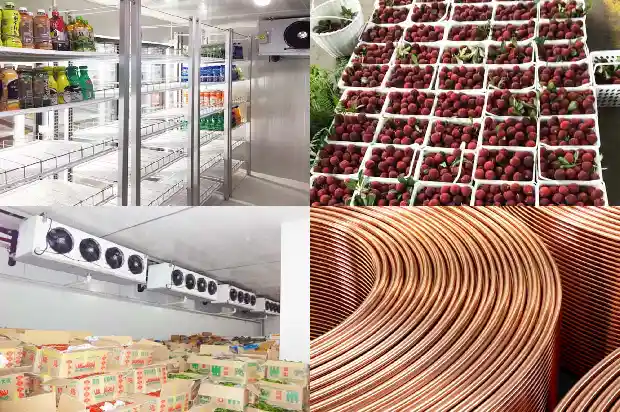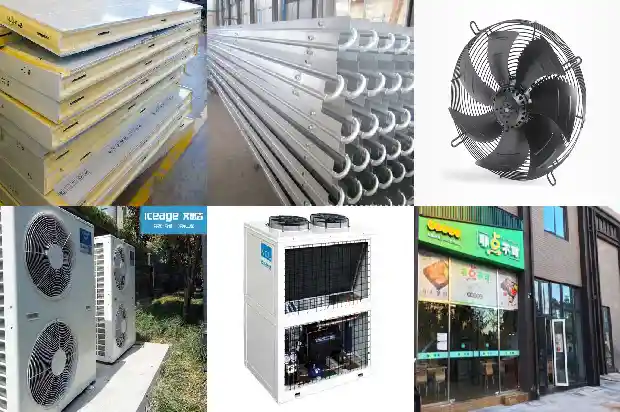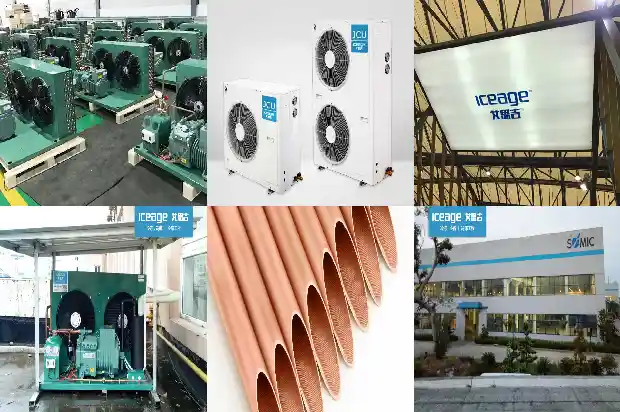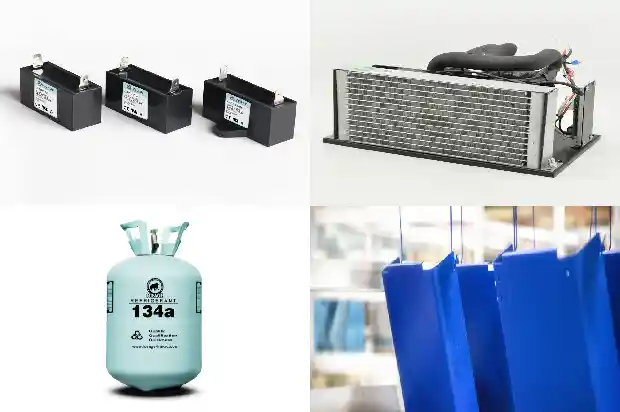Principle of Multiple Storages in One Unit and Evaporation Pressure Regulation Methods
2024-09-16
I. What is one compressor serving multiple cold storages?
A refrigeration system in which one compressor supplies cooling to several storages with different temperature requirements at the same time is called a refrigeration system with one compressor serving multiple cold storages.
According to refrigeration requirements, it is always hoped that high-temperature storages have a higher evaporation pressure, and low-temperature storages have a lower evaporation pressure. But in fact, the suction pressure of the compressor is always determined by the low-temperature storage. In order to obtain a higher evaporation pressure for the high-temperature storage and obtain a higher and constant evaporation temperature, an evaporation pressure regulating valve is installed in the return gas pipeline of the high-temperature storage. This keeps the pressure constant within a given range and makes the pressure of the refrigerant gas after the valve consistent with the suction pressure of the compressor. It not only ensures that each evaporator in the system works normally under different working conditions, but also is conducive to the compressor operating under a relatively stable suction pressure.
Let's take a look at the installation position of the evaporation pressure regulating valve in the refrigeration system, as shown below:
The evaporation pressure regulating valve is installed on the outlet pipeline of the evaporator. The evaporation pressure regulating valve is generally used in the refrigeration system with one compressor serving multiple cold storages. The function of the evaporation pressure regulating valve is to maintain the stability of the evaporation pressure of each part of the refrigeration system.
II. Evaporation pressure regulating valve and regulation of one compressor serving multiple cold storages
The working principle of the evaporation pressure regulating valve is that the valve disc is under the combined action of the refrigerant liquid pressure at the inlet and the spring force. Let's take a look at the following animated GIF, which vividly illustrates the working principle.
Adjustment of evaporation pressure regulating valve:
When adjusting the evaporation pressure regulating valve, first connect a pressure gauge. According to the temperature requirements of the cold storage, adjust the pressure to the corresponding saturated pressure that is 5-10°C lower than the maintained temperature of the cold storage.
Regulation of one compressor serving multiple cold storages:
For example, if the temperature requirement of a certain storage is +5°C and R22 is used as the refrigerant, the corresponding evaporation temperature of this storage should be between 0°C and -5°C.
For a low-temperature storage with a temperature requirement of -20°C and R22 as the refrigerant, the corresponding evaporation temperature should be between -25°C and -30°C. (Here, -30 degrees is taken, that is: to = tm + Δt = -30°C), and the corresponding evaporation pressure is 0.64 bar.
In order to stabilize the working temperature of the evaporators in high and low temperature storages in a refrigeration system with one compressor serving multiple cold storages, an evaporation pressure regulating valve is installed in the return gas pipeline of the evaporator of the high-temperature storage to control the evaporation pressure of the high-temperature storage to be stable within the required pressure range.
In addition, we also need to know about the bypass valve. The bypass valve uses the balance principle of refrigerant pressure and spring force to control the pressure at the valve inlet. As a hot gas bypass valve for energy regulation, it can provide an automatic adjustment method. When the suction pressure of the refrigeration system drops to a certain set value, the hot gas bypass valve automatically opens, that is, by bypassing high-pressure refrigerant vapor to the low-pressure side of the refrigeration system, to keep the system working normally at the set minimum suction pressure.
A refrigeration system in which one compressor supplies cooling to several storages with different temperature requirements at the same time is called a refrigeration system with one compressor serving multiple cold storages.
According to refrigeration requirements, it is always hoped that high-temperature storages have a higher evaporation pressure, and low-temperature storages have a lower evaporation pressure. But in fact, the suction pressure of the compressor is always determined by the low-temperature storage. In order to obtain a higher evaporation pressure for the high-temperature storage and obtain a higher and constant evaporation temperature, an evaporation pressure regulating valve is installed in the return gas pipeline of the high-temperature storage. This keeps the pressure constant within a given range and makes the pressure of the refrigerant gas after the valve consistent with the suction pressure of the compressor. It not only ensures that each evaporator in the system works normally under different working conditions, but also is conducive to the compressor operating under a relatively stable suction pressure.

Let's take a look at the installation position of the evaporation pressure regulating valve in the refrigeration system, as shown below:
The evaporation pressure regulating valve is installed on the outlet pipeline of the evaporator. The evaporation pressure regulating valve is generally used in the refrigeration system with one compressor serving multiple cold storages. The function of the evaporation pressure regulating valve is to maintain the stability of the evaporation pressure of each part of the refrigeration system.
II. Evaporation pressure regulating valve and regulation of one compressor serving multiple cold storages
The working principle of the evaporation pressure regulating valve is that the valve disc is under the combined action of the refrigerant liquid pressure at the inlet and the spring force. Let's take a look at the following animated GIF, which vividly illustrates the working principle.

Adjustment of evaporation pressure regulating valve:
When adjusting the evaporation pressure regulating valve, first connect a pressure gauge. According to the temperature requirements of the cold storage, adjust the pressure to the corresponding saturated pressure that is 5-10°C lower than the maintained temperature of the cold storage.
Regulation of one compressor serving multiple cold storages:
For example, if the temperature requirement of a certain storage is +5°C and R22 is used as the refrigerant, the corresponding evaporation temperature of this storage should be between 0°C and -5°C.

For a low-temperature storage with a temperature requirement of -20°C and R22 as the refrigerant, the corresponding evaporation temperature should be between -25°C and -30°C. (Here, -30 degrees is taken, that is: to = tm + Δt = -30°C), and the corresponding evaporation pressure is 0.64 bar.
In order to stabilize the working temperature of the evaporators in high and low temperature storages in a refrigeration system with one compressor serving multiple cold storages, an evaporation pressure regulating valve is installed in the return gas pipeline of the evaporator of the high-temperature storage to control the evaporation pressure of the high-temperature storage to be stable within the required pressure range.

In addition, we also need to know about the bypass valve. The bypass valve uses the balance principle of refrigerant pressure and spring force to control the pressure at the valve inlet. As a hot gas bypass valve for energy regulation, it can provide an automatic adjustment method. When the suction pressure of the refrigeration system drops to a certain set value, the hot gas bypass valve automatically opens, that is, by bypassing high-pressure refrigerant vapor to the low-pressure side of the refrigeration system, to keep the system working normally at the set minimum suction pressure.
Related Articles
- Principles, Components and Heat Recovery of Modular Units
- What are Refrigeration Equipment? What's the Principle of Chillers?
- What Is the Working Principle of Refrigeration Equipment?
- Operating Principle and Standard Installation Steps of Multi - split Systems in Refrigerant Air - conditioning Systems
- Working Principle of AC Inverter and DC Inverter Air Conditioners
- What's the principle and function of air energy?
- Principles of Refrigeration Systems and Functions of Components Explained
- Working Principle and Control Logic of Centrifugal Compressor
- Function and Working Principle of Subcooler
- Fault Analysis of Working Principle of Screw Chiller Unit
- Working Principle of Economizer for Refrigeration Compressor
- Principle and Refrigeration Process of Piston Refrigeration Compressor
- Characteristics and principles of air-cooled and water-cooled units
- Air-source heat pump: Principle of cooling and heating in one machine
- Industrial screw water chiller working principle
- Water Cooled Unit Principle of Operation and Parameter Failure Analysis
- The principle of air conditioning refrigeration
- Conditions are Required for the Construction of Small - sized Cold Storages
